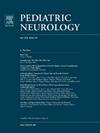Thick and Short Fetal Corpus Callosum on Ultrasound: Added Value of Fetal Magnetic Resonance Diffusion Tensor Imaging With Tractography
IF 3.2
3区 医学
Q2 CLINICAL NEUROLOGY
引用次数: 0
Abstract
Background
Thick fetal corpus callosum (CC) is a rare finding and its significance in isolation is not clear. In this retrospective study, we aim to gain insight into the microarchitecture of CC in a cohort of fetuses with thick and short CC (isolated or associated with mild extra-/intracranial abnormalities) as seen on ultrasound (US), by using prenatal magnetic resonance (MR) diffusion tensor imaging (DTI) with fiber tractography, thereby allowing better characterization for postnatal prognosis.
Methods
Twelve fetuses met the inclusion criteria on US. The fetuses were further divided into group 1 (eight of twelve) with mild intra-/extracranial abnormalities or apparently isolated and group 2 (four of 12) with callosal lipoma (CL) on US. In all fetuses, both conventional MR imaging and DTI with tractography were done on 3T MRI.
Results
DTI fiber tractography showed an aberrant midline longitudinal supracallosal bundle (ASB) in all eight fetuses in group 1. Three of four fetuses in group 2 showed normal callosal architecture, and one showed an abnormal sigmoid bundle suggestive of partial agenesis of CC.
Conclusions
We have for the first time demonstrated an ASB on MR DTI with tractography in eight of 12 fetuses with thick and short CC (isolated or mild associated intra-/extracranial abnormalities). Postnatally, ASB is reported to be associated with abnormal neurodevelopmental outcomes even in isolation and hence is important in counseling and prognosis. In fetuses with CLs, DTI would demonstrate normal or abnormal callosal architecture which is obscured by echogenicity and help in counseling.
超声显示胎儿胼胝体粗、短:胎儿磁共振弥散张量成像与输卵管造影的附加价值。
背景:厚的胎儿胼胝体(CC)是一种罕见的发现,其分离意义尚不清楚。在这项回顾性研究中,我们的目的是通过产前磁共振(MR)弥散张量成像(DTI)和纤维束造影,深入了解超声(US)上显示的厚CC和短CC(孤立或伴轻度外/颅内异常)胎儿CC的微结构,从而更好地表征出生后预后。方法:12例胎儿符合US的入选标准。胎儿进一步分为1组(8 / 12)有轻度颅内/颅外异常或明显分离,2组(4 / 12)有胼胝体脂肪瘤(CL)。所有胎儿均在3T MRI上进行常规MR成像和DTI伴输卵管造影。结果:DTI纤维束造影显示1组8例胎儿均有中线纵向胼胝体上束(ASB)异常。2组4例胎儿中3例胼胝体结构正常,1例乙状结肠束异常提示CC部分发育。结论:我们首次在12例粗短CC胎儿(孤立或轻度相关颅内/颅外异常)中发现8例MR DTI伴泪道造影显示ASB。出生后,据报道ASB与异常神经发育结果相关,即使是孤立的,因此在咨询和预后中很重要。在CLs胎儿中,DTI会显示正常或异常的胼胝体结构,这种结构被回声模糊,有助于咨询。
本文章由计算机程序翻译,如有差异,请以英文原文为准。
求助全文
约1分钟内获得全文
求助全文
来源期刊

Pediatric neurology
医学-临床神经学
CiteScore
4.80
自引率
2.60%
发文量
176
审稿时长
78 days
期刊介绍:
Pediatric Neurology publishes timely peer-reviewed clinical and research articles covering all aspects of the developing nervous system.
Pediatric Neurology features up-to-the-minute publication of the latest advances in the diagnosis, management, and treatment of pediatric neurologic disorders. The journal''s editor, E. Steve Roach, in conjunction with the team of Associate Editors, heads an internationally recognized editorial board, ensuring the most authoritative and extensive coverage of the field. Among the topics covered are: epilepsy, mitochondrial diseases, congenital malformations, chromosomopathies, peripheral neuropathies, perinatal and childhood stroke, cerebral palsy, as well as other diseases affecting the developing nervous system.
 求助内容:
求助内容: 应助结果提醒方式:
应助结果提醒方式:


